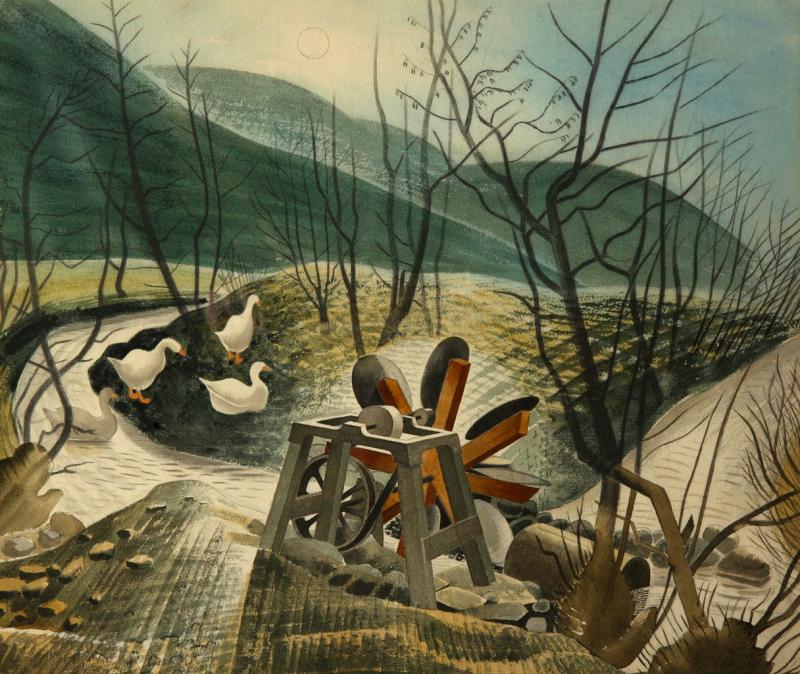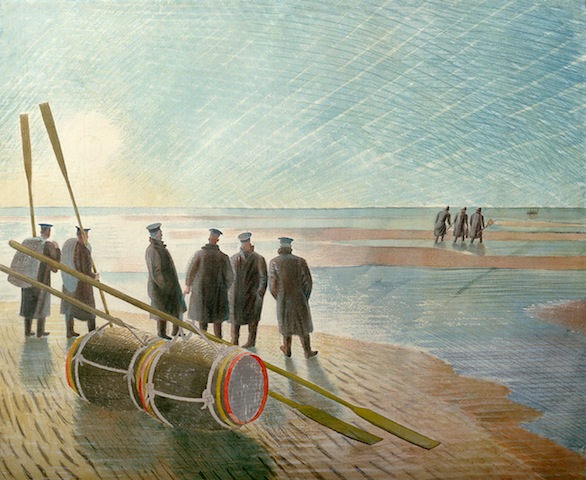Ravilious, Dulwich Picture Gallery | reviews, news & interviews
Ravilious, Dulwich Picture Gallery
Ravilious, Dulwich Picture Gallery
The ravishing and gently surreal works of one of Britain's greatest watercolourists

Look at me, and think of England. This marvellous array of quirky, idiosyncratic watercolours by Eric Ravilious (1903-1942) from the 1930s until his premature death during wartime when his plane, on an air sea rescue mission for which he had volunteered, crashed in Iceland. It is full of memorable and haunting pictures.
The images – the ancient White Horse carved on a hill; tea in the corner of an unpretentious walled garden; the view from a train window; a farmhouse bedroom; a winding country road – are almost absurdly familiar. The Thirties, after all, was the time of urban attachment to the countryside, with railways advertising away days, London underground posters improbably telling you of bucolic delights, and the innovations of the Shell county guides employing the finest of artists and photographers.
But his weaving of tiny patches of colour, hatching and drawing, outlining and filling in, provides a luminous, gently effervescent and quietly passionate series of depictions of ancient landscape, often unpeopled but marked by traces of habitation – fences, roads, machinery. The combination of the wild and the familiar is well shown in Train Landscape, 1940 (pictured below; Aberdeen Art Gallery & Museums), the comfortingly cosy compartment disturbed by the extraordinary apparition of the huge chalk horse on the ancient hill, just glimpsed as the train journeys on. The sense of almost titillating unease is subliminally exacerbated by the fact that the scene is not quite straight, the ceiling of the carriage slightly tip-tilted.
 Ravilious is hardly unknown. His Coronation Mug and designs for china are ubiquitous in the nation’s visual memory, and there was an outstanding retrospective at the Imperial War Museum in 2003, the museum's centenary year. That show included his prolific designs for everything from ceramics to glass, wood engravings, drawings and illustrated publications. There is naturally a little overlap between that show and this, including designs and prints segregated in vitrines from the wall-hanging watercolours, but the current intelligent and imaginative selection allows us to be totally absorbed up close by his almost magical way with watercolour and graphite.
Ravilious is hardly unknown. His Coronation Mug and designs for china are ubiquitous in the nation’s visual memory, and there was an outstanding retrospective at the Imperial War Museum in 2003, the museum's centenary year. That show included his prolific designs for everything from ceramics to glass, wood engravings, drawings and illustrated publications. There is naturally a little overlap between that show and this, including designs and prints segregated in vitrines from the wall-hanging watercolours, but the current intelligent and imaginative selection allows us to be totally absorbed up close by his almost magical way with watercolour and graphite.
The sharpened focus means a more profound understanding beyond the period details of his designs. Moreover his sense of structure means his paintings reproduce well, but the extraordinary spectrum of colours and variation of touch with which they are applied mean that the chance to see Ravilious in reality really should not be missed.
The compilation is a ravishing exhibition of imagery which first describes English landscape and interiors, and then scenes of wartime preparation at home, straightforward and stalwart, and often improvised. The strange cold iciness, too, of the northern seas, especially Norway, caught when on duty as an official war artist, is captivating, and allows Ravilious his special combination of both disarming us and surprising us. He is always both poised and slightly astonished.
 His highly skilled painting is simultaneously tough and resonant, edgy yet approachable, and continually, in terms of colour and touch, always offering something of the unexpected. Perhaps because of the medium as well as the subject matter, a Ravilious does not bludgeon, but rather it insinuates, often with sly humour. Here is No 29 Bus, 1934, its double decker hollowed out, becalmed in an Essex field, the body poised not on wheels but on barrels, the sky that odd paleness so typical of our weather. Six years later, in his capacity as a war artist, there is a beautiful, quietly dramatic scene on the Kent coast, Dangerous Work at Low Tide, 1940 (pictured above right; © Ministry of Defence, Crown Copyright 2015). Nine sailors work on defusing a German mine: six watching at the shore – just one facing us – as three walk towards the obstacle. The sky is shot through with shafts of angled light, diagonally echoing the beach and tidal pools.
His highly skilled painting is simultaneously tough and resonant, edgy yet approachable, and continually, in terms of colour and touch, always offering something of the unexpected. Perhaps because of the medium as well as the subject matter, a Ravilious does not bludgeon, but rather it insinuates, often with sly humour. Here is No 29 Bus, 1934, its double decker hollowed out, becalmed in an Essex field, the body poised not on wheels but on barrels, the sky that odd paleness so typical of our weather. Six years later, in his capacity as a war artist, there is a beautiful, quietly dramatic scene on the Kent coast, Dangerous Work at Low Tide, 1940 (pictured above right; © Ministry of Defence, Crown Copyright 2015). Nine sailors work on defusing a German mine: six watching at the shore – just one facing us – as three walk towards the obstacle. The sky is shot through with shafts of angled light, diagonally echoing the beach and tidal pools.
There are three characteristics of Ravilious’s art which, combined, make him so distinctive. The compositions are strongly structured with contrasting diagonals and slightly creative perspectives – a highly individual geometry. The earthbound, the grassy meadows, distant fields, farmland and beach, are shadowed, contrasted brilliantly, overarched with the sky’s luminosity, a sense of cloudy atmosphere and diffuse light bathing all in a kind of ethereal glow. This combination of a subtle radiance with sharply defined features, whether they be window frames, abandoned farm machinery, airplanes or domestic furniture, is conveyed with a multitude of tiny dabs of colour. These colour touches may be vibrant or subdued – the range when we look closely is very wide – but all is subservient to making a scene that is convincing, even though we are aware of odd perspectives and a very eccentric sense of scale.
A characteristic Ravilious is inescapably distinctive, and, in its very English fashion, gently surreal. Thus, in The Waterwheel,1938 (main picture), the geese in the background are incongruously large in contrast to the piece of machinery closest to us. But it doesn’t matter in the least; it just reminds us how art so often lies to tell the truth.
Since its refurbishment by Rick Mather in 2000, Dulwich has honed a well deserved reputation for exhibitions focusing on somewhat disregarded artists, or unusual points of view and different foci on the work of well known ones, for example, Hockney’s prints, or a succinct and sharp look at Paul Nash, or the Canadian landscape artist Emily Carr, the latter hardly known at all here. It means that beyond the glories of the permanent collection of Old Masters, the gallery, out of the way as it is in terms of ease of transport, is continually refreshed and always worth a visit, in this case for an unmissable exhibition of one of Britain’s finest painters.
Share this article
The future of Arts Journalism
You can stop theartsdesk.com closing!
We urgently need financing to survive. Our fundraising drive has thus far raised £49,000 but we need to reach £100,000 or we will be forced to close. Please contribute here: https://gofund.me/c3f6033d
And if you can forward this information to anyone who might assist, we’d be grateful.

Subscribe to theartsdesk.com
Thank you for continuing to read our work on theartsdesk.com. For unlimited access to every article in its entirety, including our archive of more than 15,000 pieces, we're asking for £5 per month or £40 per year. We feel it's a very good deal, and hope you do too.
To take a subscription now simply click here.
And if you're looking for that extra gift for a friend or family member, why not treat them to a theartsdesk.com gift subscription?
more Visual arts
 'We are bowled over!' Thank you for your messages of love and support
Much-appreciated words of commendation from readers and the cultural community
'We are bowled over!' Thank you for your messages of love and support
Much-appreciated words of commendation from readers and the cultural community
 Lee Miller, Tate Britain review - an extraordinary career that remains an enigma
Fashion photographer, artist or war reporter; will the real Lee Miller please step forward?
Lee Miller, Tate Britain review - an extraordinary career that remains an enigma
Fashion photographer, artist or war reporter; will the real Lee Miller please step forward?
 Kerry James Marshall: The Histories, Royal Academy review - a triumphant celebration of blackness
Room after room of glorious paintings
Kerry James Marshall: The Histories, Royal Academy review - a triumphant celebration of blackness
Room after room of glorious paintings
 Folkestone Triennial 2025 - landscape, seascape, art lovers' escape
Locally rooted festival brings home many but not all global concerns
Folkestone Triennial 2025 - landscape, seascape, art lovers' escape
Locally rooted festival brings home many but not all global concerns
 Sir Brian Clarke (1953-2025) - a personal tribute
Remembering an artist with a gift for the transcendent
Sir Brian Clarke (1953-2025) - a personal tribute
Remembering an artist with a gift for the transcendent
 Emily Kam Kngwarray, Tate Modern review - glimpses of another world
Pictures that are an affirmation of belonging
Emily Kam Kngwarray, Tate Modern review - glimpses of another world
Pictures that are an affirmation of belonging
 Kiefer / Van Gogh, Royal Academy review - a pairing of opposites
Small scale intensity meets large scale melodrama
Kiefer / Van Gogh, Royal Academy review - a pairing of opposites
Small scale intensity meets large scale melodrama
 Jenny Saville: The Anatomy of Painting, National Portrait Gallery review - a protégé losing her way
A brilliant painter in search of a worthwhile subject
Jenny Saville: The Anatomy of Painting, National Portrait Gallery review - a protégé losing her way
A brilliant painter in search of a worthwhile subject
 Abstract Erotic, Courtauld Gallery review - sculpture that is sensuous, funny and subversive
Testing the boundaries of good taste, and winning
Abstract Erotic, Courtauld Gallery review - sculpture that is sensuous, funny and subversive
Testing the boundaries of good taste, and winning
 Edward Burra, Tate Britain review - watercolour made mainstream
Social satire with a nasty bite
Edward Burra, Tate Britain review - watercolour made mainstream
Social satire with a nasty bite
 Ithell Colquhoun, Tate Britain review - revelations of a weird and wonderful world
Emanations from the unconscious
Ithell Colquhoun, Tate Britain review - revelations of a weird and wonderful world
Emanations from the unconscious
 Rachel Jones: Gated Canyons, Dulwich Picture Gallery review - teeth with a real bite
Mouths have never looked so good
Rachel Jones: Gated Canyons, Dulwich Picture Gallery review - teeth with a real bite
Mouths have never looked so good

Add comment